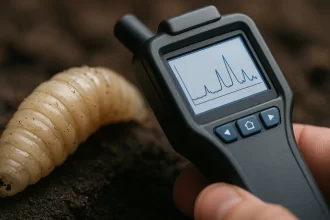Introduction
- Understanding Soil Composition and Formation
- The Tapestry of Earth’s Soils
- Soil: Nature’s Distinctive Identifier?
- The Key Attributes of Soil as Forensic Evidence
- Analyzing Soil: Unveiling Its Secrets
- The Complexity and Uniqueness of Soil Examination
- The Revelation: What Soil Analysis Unearths
- In Conclusion
In forensic science Discover the fascinating field of Forensic Science, the application of scientific principles to legal matters. This post delves into its many disciplines, from DNA analysis to crime scene investigation, its importance in the justice system, Read Full Definition, where investigators painstakingly analyze every detail of a crime scene, one element often takes a back seat to more conspicuous evidence
Discover the fascinating field of Forensic Science, the application of scientific principles to legal matters. This post delves into its many disciplines, from DNA analysis to crime scene investigation, its importance in the justice system, Read Full Definition, where investigators painstakingly analyze every detail of a crime scene, one element often takes a back seat to more conspicuous evidence Evidence is any form of proof, such as objects, materials, or scientific findings, presented to establish or disprove a fact in a legal proceeding. It is used to reconstruct events and link or exclude individuals Read Full Definition like fingerprintsFingerprint, impression made by the papillary ridges on the ends of the fingers and thumbs. Fingerprints afford an infallible means of personal identification, because the ridge arrangement on every finger of every human being is Read Full Definition and DNA
Evidence is any form of proof, such as objects, materials, or scientific findings, presented to establish or disprove a fact in a legal proceeding. It is used to reconstruct events and link or exclude individuals Read Full Definition like fingerprintsFingerprint, impression made by the papillary ridges on the ends of the fingers and thumbs. Fingerprints afford an infallible means of personal identification, because the ridge arrangement on every finger of every human being is Read Full Definition and DNA DNA, or Deoxyribonucleic Acid, is the genetic material found in cells, composed of a double helix structure. It serves as the genetic blueprint for all living organisms. Read Full Definition. This unsung hero is soil, classified as trace evidenceTrace evidence - Physical evidence that results from the transfer of small quantities of materials (e.g., hair, textile fibers, paint chips, glass fragments, gunshot residue particles). Read Full Definition, but bearing immense importance in crime scene investigation. In this in-depth exploration, we delve into the forensic significance of soil, its unique properties, and its crucial role in solving crimes.
DNA, or Deoxyribonucleic Acid, is the genetic material found in cells, composed of a double helix structure. It serves as the genetic blueprint for all living organisms. Read Full Definition. This unsung hero is soil, classified as trace evidenceTrace evidence - Physical evidence that results from the transfer of small quantities of materials (e.g., hair, textile fibers, paint chips, glass fragments, gunshot residue particles). Read Full Definition, but bearing immense importance in crime scene investigation. In this in-depth exploration, we delve into the forensic significance of soil, its unique properties, and its crucial role in solving crimes.
Understanding Soil Composition and Formation
To comprehend soil’s forensic significance, it’s essential to understand its composition and how it comes into being. Soil is an intricate blend of rock particles, minerals, organic matter from plants and animals, and even man-made substances. It is the result of a complex process that involves the weathering of rocks and minerals, followed by the breakdown of organic matter by living organisms and the influence of human activities.
What makes soil truly fascinating is its diverse components, including remnants of various plants, animal debris, and human-made materials such as glass, fertilizers, and plastics. This unique amalgamation renders soil specific to particular locations. Furthermore, human activities like mining, agriculture, and industrial operations contribute to the diversity of soil types found around the world.
The Tapestry of Earth’s Soils
Our planet boasts an impressive variety of soil types, each with distinct characteristics. Soil properties, such as color, texture, and structure, offer valuable insights into its composition and origin. The coloration of soil, for instance, is a direct result of the minerals present within it. Varied proportions of clay, silt, and sand contribute to different soils’ diverse structures and textures.
These unique properties are instrumental in identifying the origin of soil, which, in turn, aids in classifying a crime scene as either a primary or secondary location.
Soil: Nature’s Distinctive Identifier?
While some experts have drawn parallels between soil and human fingerprints due to their uniqueness, this comparison has its limitations. Nevertheless, natural soils can be differentiated from man-made counterparts based on their compositions. The value of soil as evidence lies in its prevalence at crime scenes and its ability to transfer between the scene and the perpetrator. The physical, chemical, and biological characteristics of soil become paramount in forensic examination.
The Key Attributes of Soil as Forensic Evidence
The properties that make soil a significant form of evidence are its individuality and transferability. Soil components exhibit varied physical, chemical, biological, and mineralogical properties unique to each location, a concept often referred to as the Law of Individuality.
Moreover, these individual characteristics are influenced by geographical factors, anthropogenic activities, and climatic conditions. Soil comprises tiny particles easily transferable from one surface to another, adhering to Locard’s Principle of Exchange. Consequently, traces of soil can be found on footwear, clothing, or even on the bodies of victims or culprits.
As mentioned earlier, soil is considered trace evidence, increasing the likelihood that culprits may overlook it on their clothing, footwear, or belongings. This oversight can be instrumental in helping investigators connect suspects to crime scenes and victims.
Analyzing Soil: Unveiling Its Secrets
The analysis of soil involves several methodologies designed to unlock its mysteries. Color, texture, and structure can be assessed through various analytical methods, such as spectroscopy and X-ray diffraction. Spectroscopic examination focuses on soil color, while X-ray diffraction delves into mineral components.
One of the remarkable aspects of soil analysis is its efficiency. Soil is relatively easy to locate, collect, and separate, making the analysis process both time and cost-effective.
The Complexity and Uniqueness of Soil Examination
Soil analysis primarily relies on principles of comparison involving visual examination and microscopic analysis. However, the heterogeneous nature of soil can make these examinations complex. It’s important to note that differentiating between standard and non-standard methods of soil examination remains a significant challenge.
The physical properties of soil, such as density and refractive index, play a vital role in individualizing it. Soil often exhibits birefringence, displaying varying refractive indices when illuminated from different angles.
The Revelation: What Soil Analysis Unearths
Soil analysis serves various critical purposes in forensic investigations. It helps delineate the geographical extent of a crime scene, assesses the likelihood of a burial or clandestine grave, and even aids in tracking the movement of scents using human remains detection dogs. Furthermore, soil analysis can determine the soil type from an unknown sample.
Moreover, soil examination can assist in determining the age of bones, a crucial factor in preserving DNA for typing purposes. It also aids in estimating the time of death and the stage of skeletonization. Microscopic methods employed in soil analysis reveal intricate details about particle structure and unique components such as pollen grains, seeds, paint chips, plastic particles, minerals, and more. These components provide vital insights into the origin and nature of the soil.
In certain cases, soil soaked in biological fluids may be discovered, offering valuable forensic evidence for analyzing biological fluids and, consequently, identifying their sources.
In Conclusion
Soil, often overshadowed by more overt forms of evidence, emerges as a potential treasure trove of trace evidence at nearly every crime scene. Its ubiquity across the Earth’s surface makes it a common yet invaluable source of forensic information. Even trace amounts of soil can hold critical clues, sometimes overlooked by investigators but instrumental in advancing forensic analyses.
In cases where traditional evidence like fingerprints, DNA, or witness statements may be lacking, the analysis of soil steps into the spotlight. It offers a robust and reliable source of corroborative evidence, enhancing the depth and breadth of criminal investigations.
Criminals may underestimate the silent witness that is soil, but investigators must recognize its significance and conduct thorough forensic analyses. Soil, in its unassuming way, can provide the key to unlocking mysteries and bringing justice to the forefront of the legal landscape.












